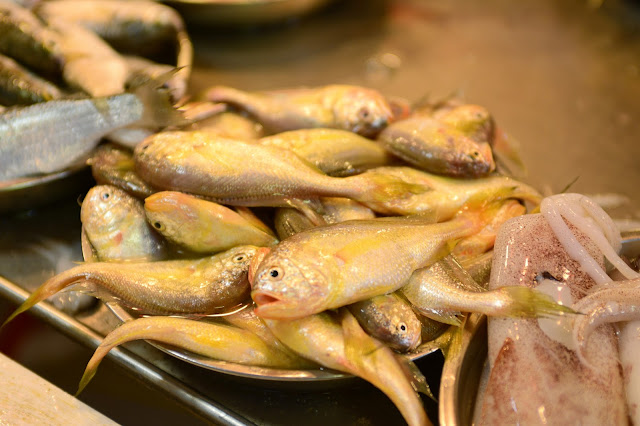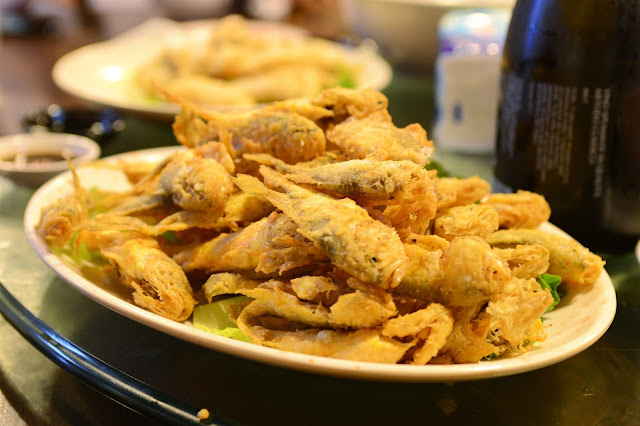A few weeks ago my friend R organized a lunch for his foodie/jetsetter friends J and G who were travelling from across the ocean and spent a few days in town, and he asked a few of us to join them for a meal at Ap Lei Chau, the island in southern part of Hong Kong famous for the freshest seafood available at the indoor market and a few restaurants upstairs which can prepare them in any way you requested.
We met up at the market slightly after noon, and our chef friend D was already busy buzzing around the stalls looking for ingredients for our lunch (and for dinner service at his restaurant). This part of town has long been a fishing village, going way back before Hong Kong was even conceived, and that tradition continues to this date. Most of the stalls at the market received their goods daily either from the wholesale market nearby, or directly from the fishing boats travelling near and far to catch.
If there’s a thing as the best time to visit the market, it’s going to be August, when it marked the end of the government mandated “fishing moratorium”, which runs through the summer for the protection of ocean eco-system and prevent over-fishing in the region. With the fishing operation resumed after a 2 month hiatus, this is the time we see the biggest supply of seafood available in the market, both in quantity and variety. It’s an eye-opener just browsing through different stalls looking at what’s available – some were more familiar, but there were a number of rarer finds as well. We had to control ourselves not to (over) buy too much.
After we were done and happy with what we got, we walked across the street to the restaurant with our shopping goods. Normally we went for one of those places inside the market just a floor up, but with a few of them not open for business on the day, we went to this one next to the market building instead which was recommended by D. They specializes in Chiuchow cuisine but they also do seafood due to its proximity to the market. And after a brief inspection of the items we got, their chef already knew what to do with them and got on with the cooking inside the kitchen.
With such fresh ingredients one didn’t really need to do much with seasonings and too elaborate preparations. We began with a plate of Babylon Shells (花螺), steamed and served with chili soy sauce on the side. Those small shellfish, which looked like mini turban snails, has a great bouncy texture and a hint of umami sweetness – all that’s needed was a quick dip to the soy sauce to bring out all its flavor. Same for the striped prawns (九節蝦) (known as kuruma-ebi in Japanese) – this is the time of year that we saw the most variety of different wild prawns available in the market, but nothing caught our eyes more than this prawns known for its distinct stripes on the body. This is the tastiest one among all that are commonly found around this region. Two soups were then served – one fish soup with potatoes and tomatoes, and another the giant clam soup with black peppers and glass noodles. Both were done family-style with just a quick boil, but both were tasty thanks to the great ingredients.
We then followed with a series of deep-fried items, including the mantis shrimp (done with fried garlic), Bombay duck fish (九肚魚) and Lion-head fish (獅頭魚) (both battered and deep-fried). My favorite was the lion-head fish, a baby croaker around palm-sized and recognizable by its big head. As they have been deep-fried, the whole fish was edible from head to tail. We quipped this was like a Cantonese version of “Fish and Chips” – well, at least half of it. They surely made wonderful snacks to go with beer and alcohol - they remained crispy even as they were cooled down. I also loved the plate of cuttlefish, cut in chunks, battered, deep-fried and stir-fried with garlic and vegetables. Another simple dish perfectly done.
Of course, a Cantonese seafood lunch would not be complete without steamed fish – and this time, we didn’t have just one whole fish but 7. Threadfin Butterfly fish (荷包魚) is one of those "mysterious" species that one often see in pictures or hear people talking about eating them, but it’s hard to find in the market because they can only be caught in the wild near the coral reef and of limited quantity. But this time we were happy to find a batch of six available and we didn’t hesitate to take them all up. The best way to cook is just simply steamed with scallions and a pinch of salt and that’s how they were done. Other than the delicate meat in the fish, the best part was actually the skin and the meat attached to the bones, full of the unique clean oily flavor. Quite a hassle to work on a small fish like these (each was about the size of my palm) but it’s well worth the effort with such awesome flavor. We also had a whole star snapper (海石蚌) – also caught wild – to share among us. It’s another rare finds in the market and I love its clean flavor with rich umami.
And that’s not the end of it. August also marked the beginning of crab seasons, starting with the virgin mud crabs (奄仔蟹), active in the brackish water region near the Pearl River Delta. The crabs were rich in roes which has an intense flavor, which contrasted with the mild crab meat inside. We ran across this giant eel in one of the market stalls and decided to pick that up as well. Took a while for that to steamed, and served with black bean and soy sauce. Texture was excellent due to its size, but we thought it could do with more marinate before it’s cooked.
Overall, a great afternoon outing catching up over wonderful catches.
When? August 28 2018
Where? Chenghai Kitchen (澄海小館), Yuet Hoi Street, Ap Lei Chau, Hong Kong
Menu Highlights? Steamed Butterfly Fish, Deep-fried Lion-head Fish
Drinks?
Feudi Di San Gregorio DUBL+ Greco Brut NV
2015 Domaine Philippe Valette Macon Villages














No comments :
Post a Comment